The Best Mango Lassi Recipe (Restaurant-Style)
Hello and welcome to the BEST Mango Lassi recipe on the internet. This recipe makes better-than-restaurant Mango Lassi with six easy-to-find ingredients. The base of the recipe is strong while allowing you to adjust to taste according to your mangoes. Tested to perfection!
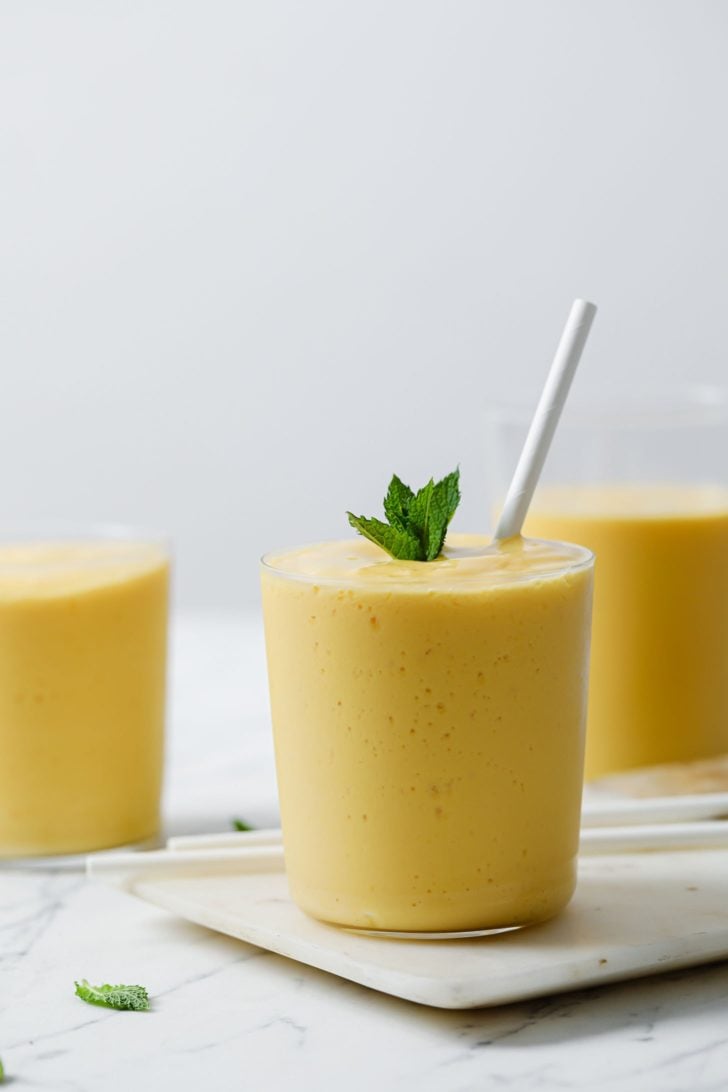
Want to save this post?
Enter your email below and get it sent straight to your inbox. Plus, get recipes & tips every week!
“Unbelievably, unbelievably perfect.”
Randi
I rarely find the audacity to call one of my recipes ‘the best’. And even when I do, I remain unsure despite solid feedback confirming my biases. (See Chicken Biryani or Instant Pot Kheer).
Perfection doesn’t exist. The ‘best recipe’ doesn’t exist. We all know that. But we can get close. And after 25+ tests in comparison with 7 different Houston restaurants, I’d say this is realllyyy close.
What is Lassi?
Lassi is a yogurt-based drink that’s said to have originated in Punjab. Traditionally, people made lassi by hand-blending homemade yogurt with water and salt. It served as cooling hydration against the intense summer heat of the Indian subcontinent. Today, most people drink sweet lassi more often than salted.

What is Mango Lassi?
Mango Lassi is a sweet and tart lassi flavored with mangoes (whether fresh, pulp, or both). Thanks to Indian restaurants, Mango Lassi has become the most well-known version of lassi around the world.
It’s interesting to note that despite Mango Lassi’s popularity, it’s not the most commonly made lassi in many South Asian households. For example, during visits to Pakistan, we would have mango milkshake or mangoes followed by lassi. But Mango Lassi itself wasn’t conceptualized.

What makes this recipe so special?
You’d think a ‘throw-it-together’ recipe like lassi wouldn’t need such obsession. But it took countless trials with all sorts of mangoes and yogurts and pulps to get this recipe where I want it. Here’s why you’ll love it:
- The ratios are precise. We’re talking grams, even for the ice cubes.
- It’s strong in mango flavor but not overly sweet, ‘pulpy’, or artificial-tasting.
- It works with whatever mangoes you’ve got on hand. Perfectly ripe, seasonal mangoes? You’re in luck! Store-bought frozen? I’ve got you covered!
- It’s cold and stays cold until the last sip. No room temperature lassi issues!
- The base of the recipe is strong but it still allows you to customize it to taste.
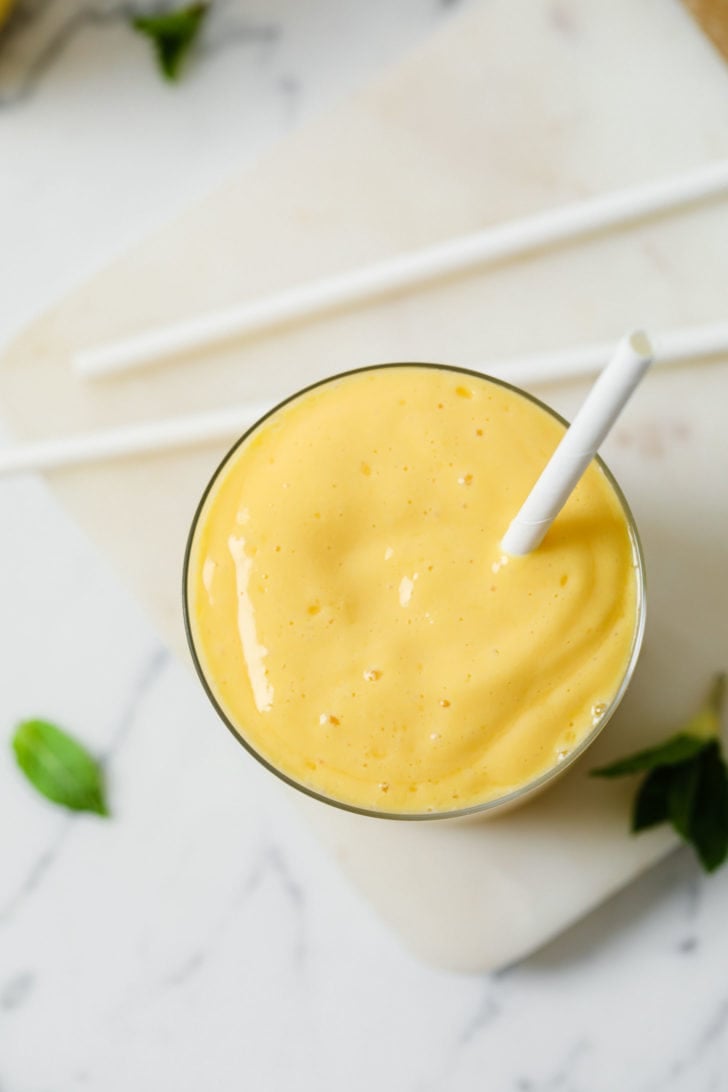
Notes on the Ingredients for Mango Lassi
This recipe requires six ingredients, and each plays an important part in the flavor and consistency. Here’s what you need to know about them:
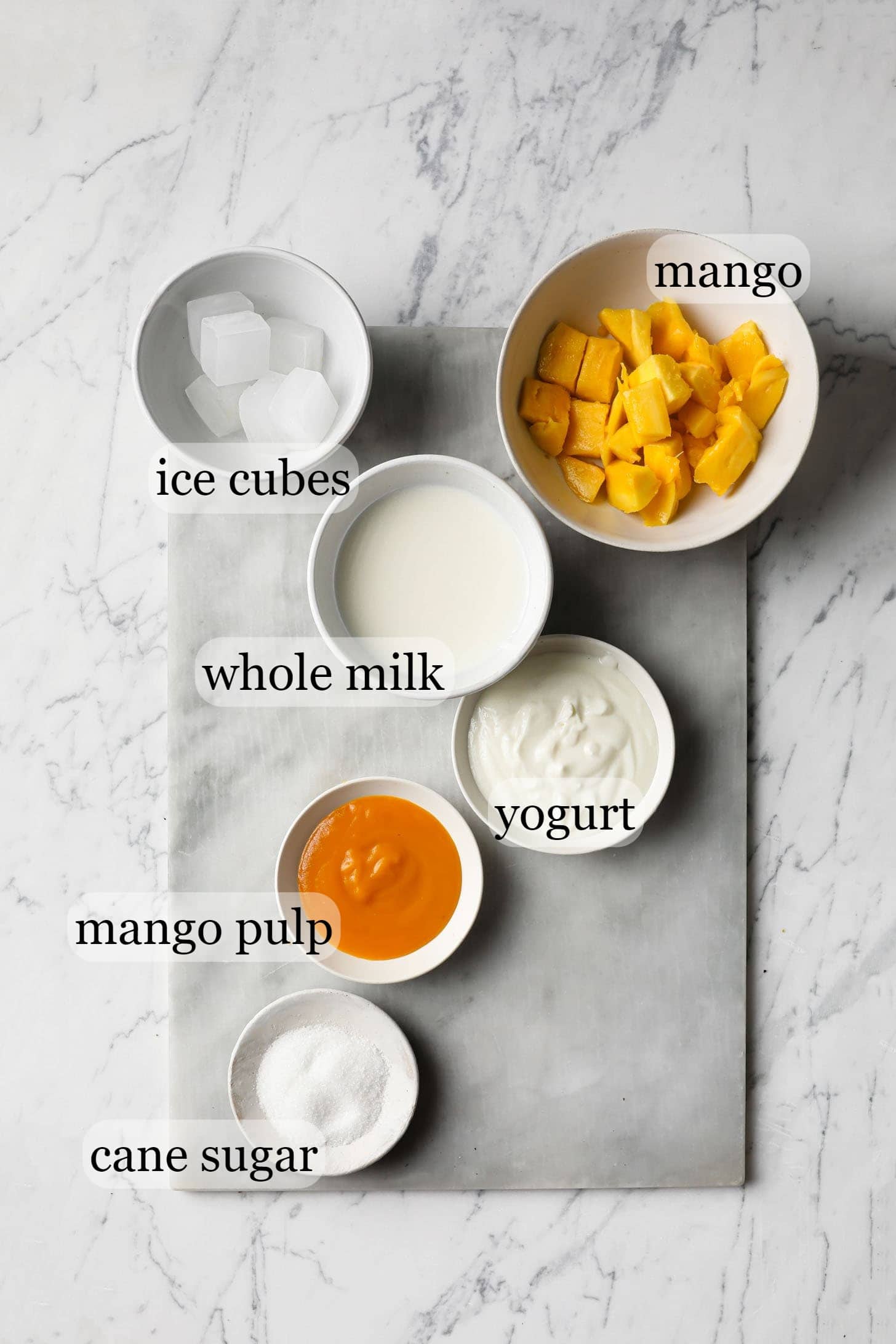
- Mangoes: You can use any mangoes for this recipe, but the most important part is that your mangoes be ripe. I’ve discussed what type of mangoes to use, how to tell when they’re ripe, and how to cut and freeze below.
- Whole Milk: Milk adds a rich base to lassi and keeps it fluid instead of heavy and dense.
- Dairy-free: I haven’t tried making this dairy-free but Minimalist Baker has this vegan version that looks fantastic. She uses frozen mangoes as well!
- Plain, whole milk yogurt: Use the thicker part of yogurt for the recipe. Yogurts vary in natural sugars and sourness. Depending on how tart your yogurt is, you may need to increase it to taste.
- I haven’t tried it, but I think Greek yogurt (especially the European kind) can also work. If you’d like to use it, try adding less than amount in the recipe so the lassi stays runnier in consistency.
- Store-bought Sweetened Mango Pulp: It’s very important that you use Indian mango pulp (usually made from Alphonso or Kesar mangoes). This comes in large cans at South Asian grocery stores, and must be removed & stored to prevent rusting.
I tried hard to make pulp an optional ingredient, but I found it’s essential for 2 reasons:- Mango Pulp helps compensate for ‘okay’ mangoes or store-bought frozen mangoes. But even if you use great mangoes, a small amount enhances the mango flavor and color.
- It’s almost always used at restaurants, so if you want a ‘restaurant-style’ lassi, you can’t get the flavor without it.
- All that said, if you can’t find Indian mango pulp, you’ll still get the best mango lassi as long as your mangoes are ripe and delicious. Add a bit extra mango (up to 1 cup/~170g total) and 1/2-1 tbsp extra sugar to compensate for sweetness.
- Cane Sugar: I use pure cane sugar, but regular sugar is fine. Feel free to use your favorite sweetener here as long as it isn’t overpowering in taste.
- Ice cubes: Not only does the ice chill the lassi, but it provides water content so the lassi isn’t too heavy.
Mangoes for Lassi
Ah I could talk about mangoes all day. Here’s more on which mangoes to use, how to tell when they’re ripe, and how to cut + freeze them for lassi.
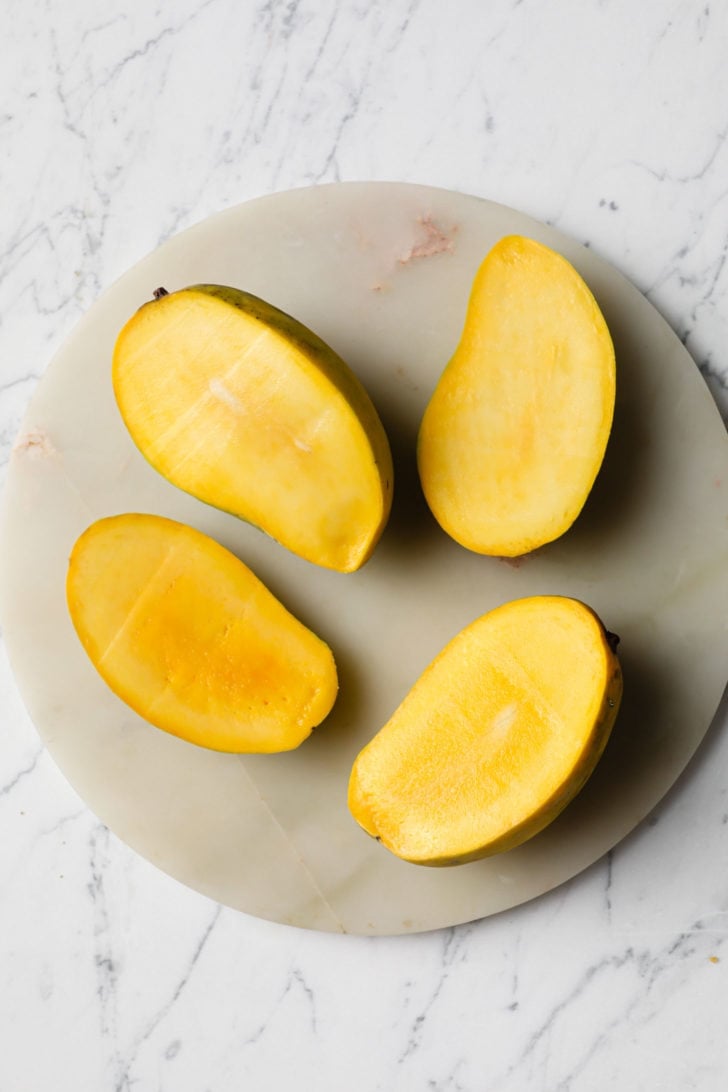
Which Type of Mangoes are Best for Mango Lassi
If you have a choice between mangoes, go for the one with less fibers (i.e. the less stringy ones).
Here in the U.S., we don’t have have a wide variety of mangoes. The most common around me are Tommy Atkins or Champagne (also called Ataulfo or Honey). Because Tommy Atkins are more fibrous and typically less sweet, I recommend you use Champagne/Honey. (In the U.K., Champagne may not be available.)
If you can’t find Champagne, another great option is to use frozen mangoes which are often imported from Peru. (I’ve tried the ones from Trader Joe’s & HEB). If using store-bought frozen, you’ll need to use the higher amount of pulp for best results.
Lastly, if you live near a large city, you can try getting Pakistani or Indian mangoes from South Asian grocery stores or even online. Here in Houston, I found Anwar Ratol & Chaunsa, both which worked beautifully in Mango Lassi.
Note: In the pictures, we’ve used Pakistani mangoes (Chaunsa) while the video shows Champagne.
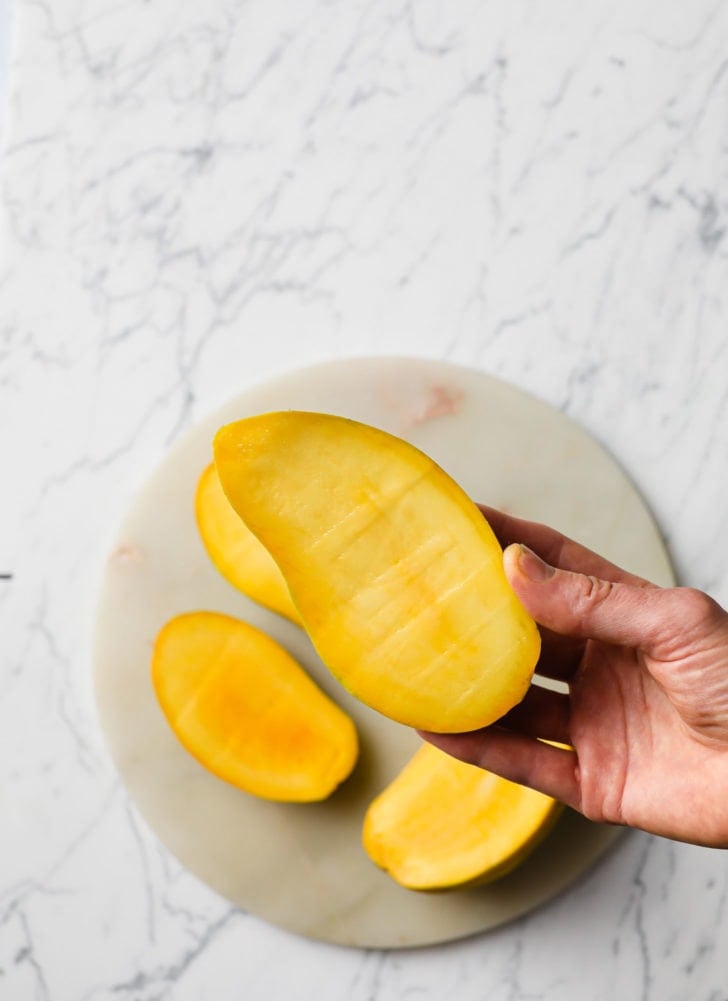
How to Tell When Mangoes are Ripe
Like most fruit, mangoes show ripening by feel and color. Champagne mangoes are ripe when they:
- Turn a deep, golden yellow color.
- Are soft and tender instead of firm.
- Start to show juices coming out from the stem.
- Begin to show wrinkling of the skin.
How to Cut & Freeze Mangoes for This Recipe
The goal is to separate the ripe flesh of the mango from the large pit in the center:
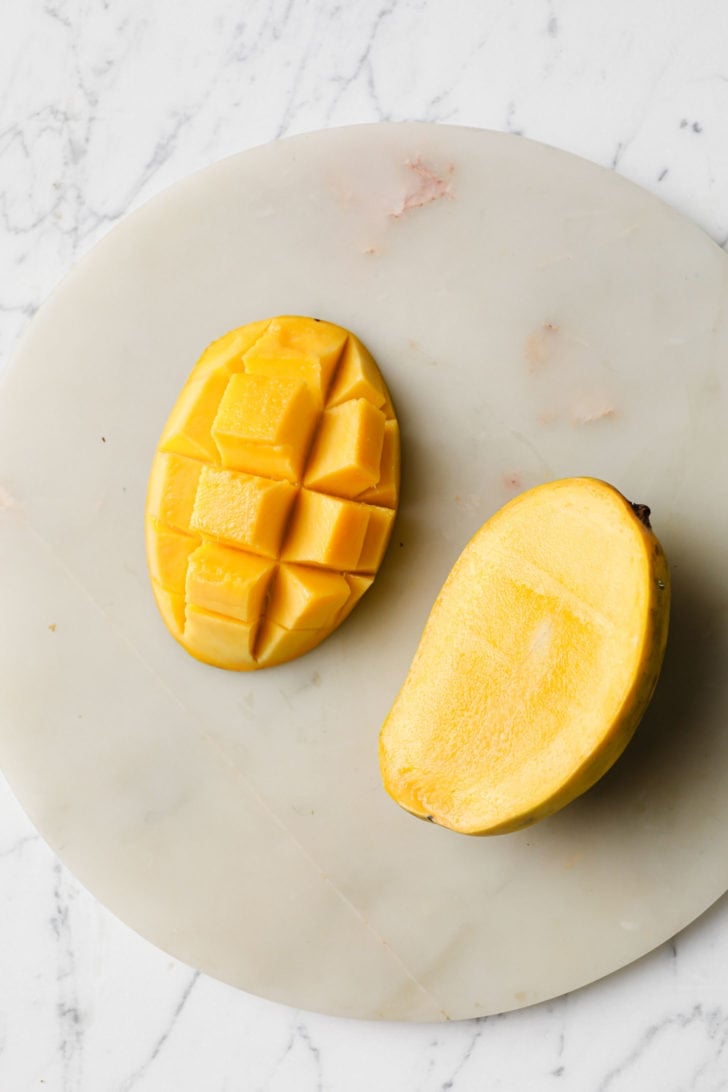
- Cut lengthwise around the large pit in the middle. Cube the flesh and remove with a spoon (see picture & video)
- Next, use a small paring knife to cut around the pit in the flow of the fibers.
- Cube and remove the flesh from the thin strips.
- Try to salvage the flesh around the pit as much as you can.
- Place the chopped cubes and pieces in an airtight container or bag until ready to use. When ready to use, separate a few cubes with your hands to make it easier to blend.
How to Make Mango Lassi
Here’s the kicker. This recipe suggests that you freeze your ripe mango before using it to make mango lassi. Not only does this give the lassi a better texture, but it brings out the mango flavor. Plus, it stays cold until the last sip. Once your mangoes are frozen, you’re ready to make the lassi:
- Add all the ingredients to a high-speed blender, using the lower amount for pulp and sugar. Blend on high speed until smooth and no longer icy. If the mixture gets stuck, use the blender tamper or stop and push it down with a spatula.
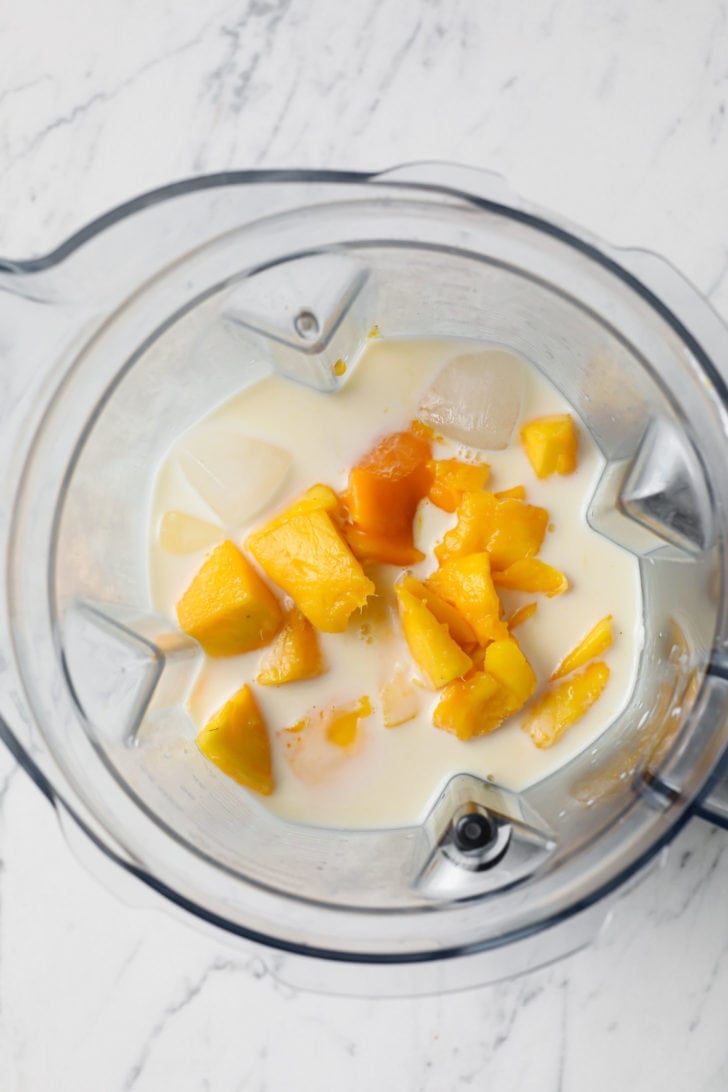
- Taste and adjust flavor as needed, adding sugar for sweetness, pulp for more mango flavor/color, or 1-2 tbsp of yogurt for tartness. Initially, you’ll notice it looks thick like a smoothie. But, it’ll quickly become pourable and runnier, like traditional Mango Lassi.
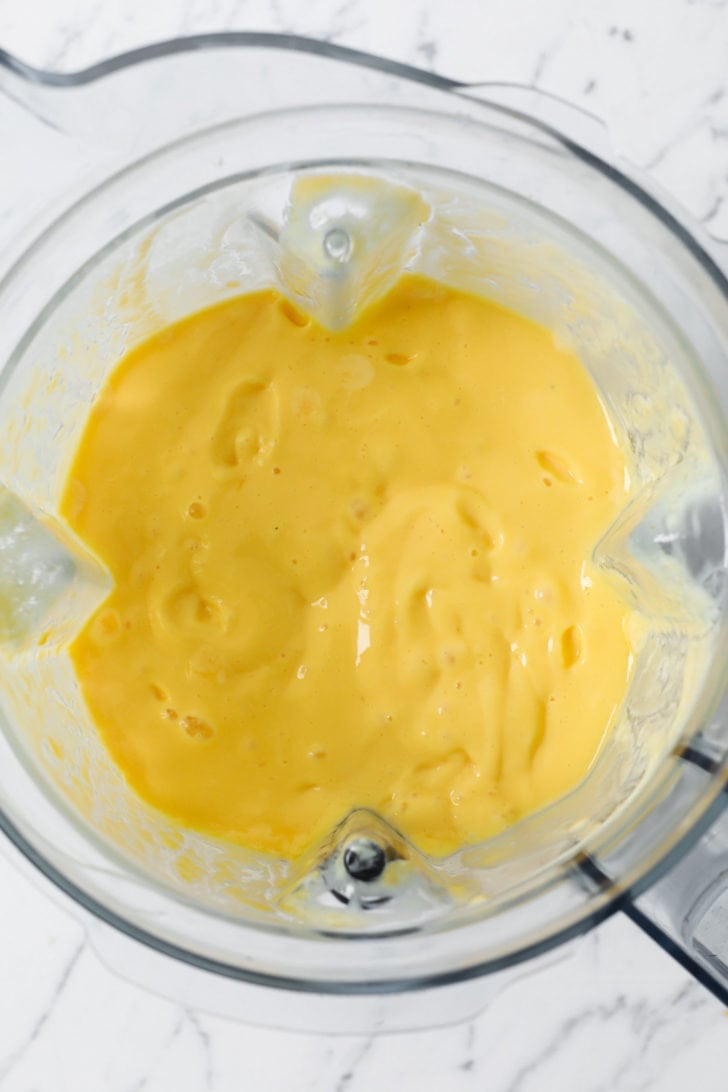
This recipe makes 2 small (~8-9 oz) servings or 1 large lassi if you don’t want to share. (Completely understandable.)
Variations
- Cardamom Powder: A small pinch of cardamom powder or ground cardamom is a nice variation.
- Rose water: A refreshing touch, but add only a drop because it can easily get overwhelming.
- Sea salt: Just like plain lassi, mango lassi takes well to a pinch of sea salt.

A Final Tip before you start
If you have a weighing scale, use it to measure out the ingredients, especially the mangoes. Depending on how the mango is cubed, it’ll yield different amounts in cups. If you don’t have a weighing scale, chop the mango into into 1/2″ cubes and measure before freezing.
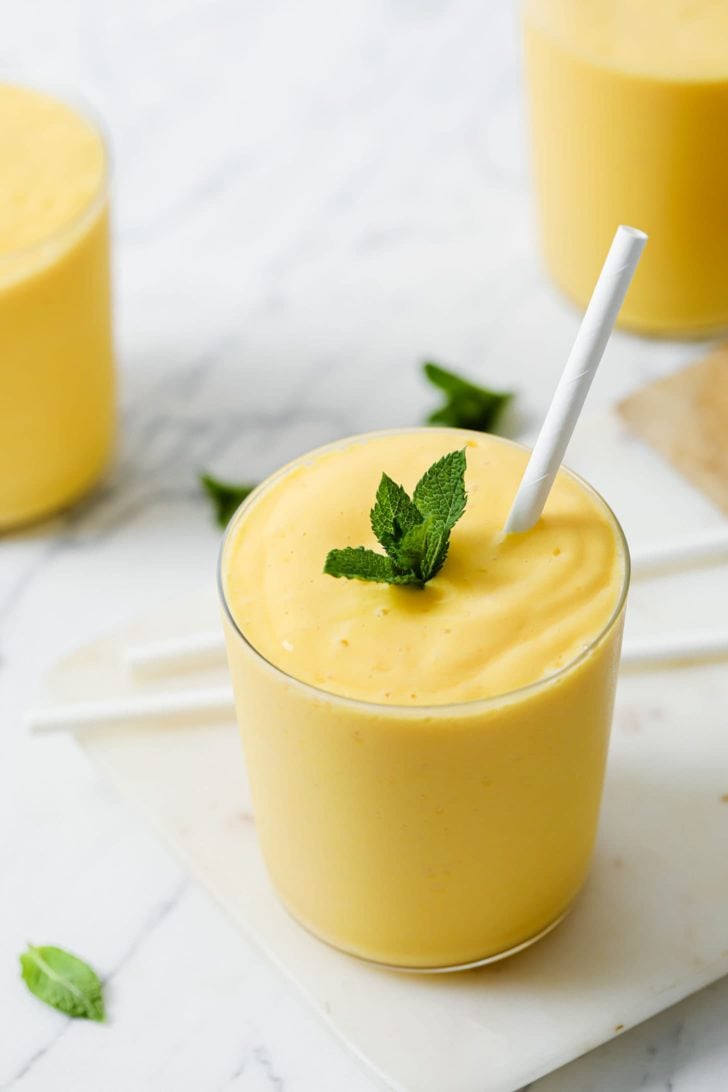
How and When to Serve Mango Lassi
There aren’t any rules for when you can have Mango Lassi, but I prefer it after a meal or as a refreshment between meals. Ice in the recipe ensures that it’s served chilled.
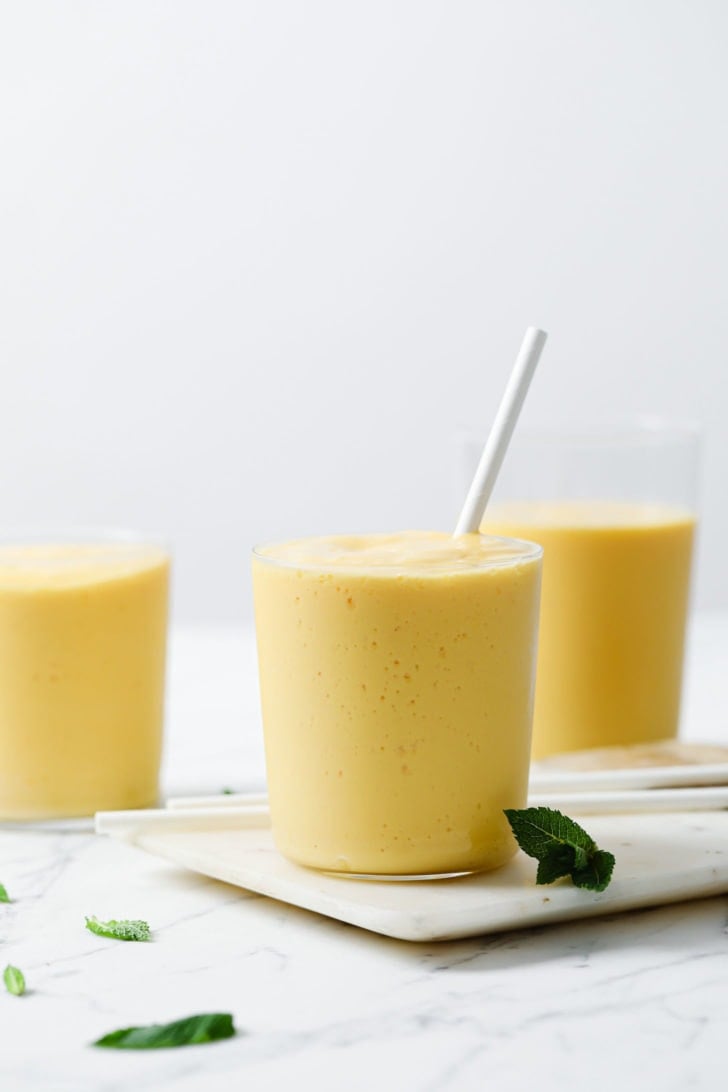
More Indian & Pakistani Drink Recipes You’ll Love
- Masala Chai
- The Perfect Sweet Lassi
- Authentic Pakistani Chai
- 20-Minute Kashmiri Chai (Pink Tea)
- Authentic Turmeric Milk Tea – Golden Milk | Haldi Ka Doodh
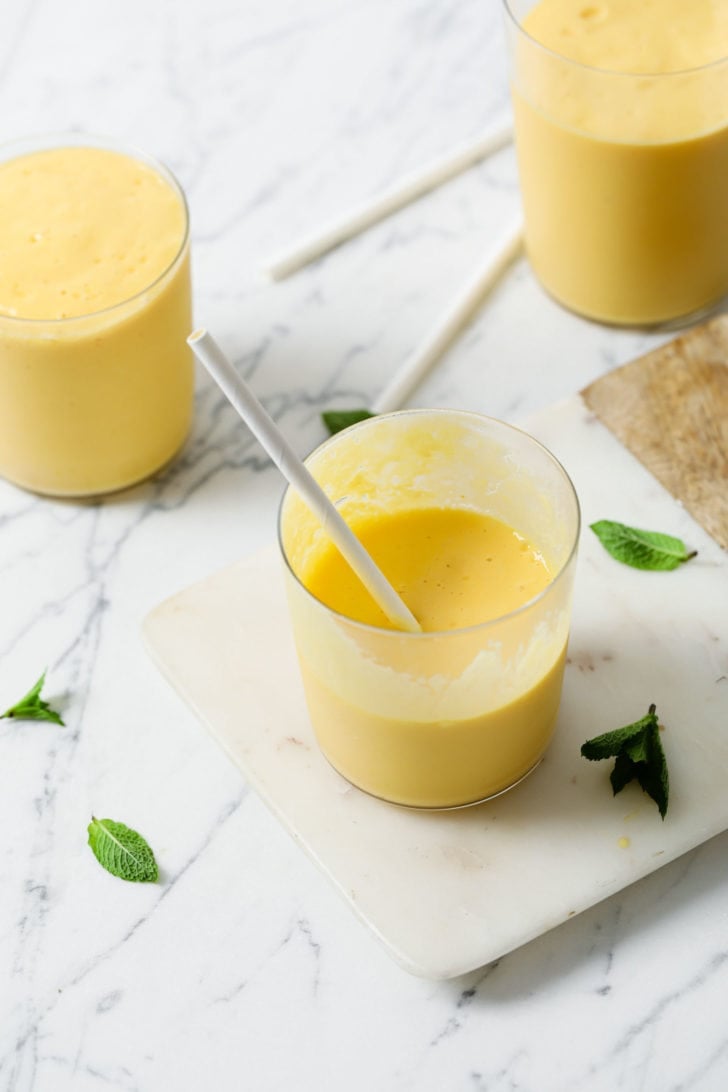
Tried this recipe? If you have a minute, please consider leaving a comment telling me how it was! If you’re on Instagram, please tag me so I can see your creations. I truly love hearing from you. Thank you!

The Best Mango Lassi (Restaurant-Style)
Watch the Video
Ingredients
- 3/4 cup (~135-145 g) ripe mango, preferably previously frozen (See Note 1), I use Champagne (also called Ataulfo or Honey)
- 1/2 cup (118 ml) whole milk
- 1/3 cup + 1 tbsp (~98 g) plain, whole-milk yogurt
- 2-4 tbsp (40-80 g) store-bought Indian mango pulp (See Note 2), sweetened
- 1.5-2 tbsp cane sugar, depending on how sweet your mango is
- 3 large/7-8 small (70-100 g) ice cubes, use lower amount if using frozen mangoes
Equipment
- High-Speed Blender
Instructions
- Add mango, milk, yogurt, mango pulp (start with lower amount), cane sugar (start with the lower amount), and ice cubes to a high-speed blender.
- Blend on high until smooth and no longer icy. If the mixture gets stuck, use the blender tamper or stop and push it down with a spatula. Taste and add remaining sugar for sweetness, pulp for more mango flavor/color, or 1-2 tbsp of yogurt for tartness. Initially, it’ll look like a smoothie, but it’ll quickly become pourable and runnier, like mango lassi.
- Serve immediately or store, covered, in the fridge for up to 24 hours before it starts losing freshness.
Notes
- 1 – Mango pulp helps compensate for ‘okay’ mangoes or store-bought frozen mangoes. But even if you use great mangoes, a small amount enhances the mango flavor and color.
- 2 – It’s almost always used at restaurants, so if you want a ‘restaurant-style’ lassi, you can’t get the flavor without it.


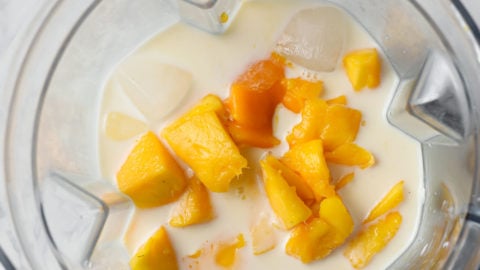
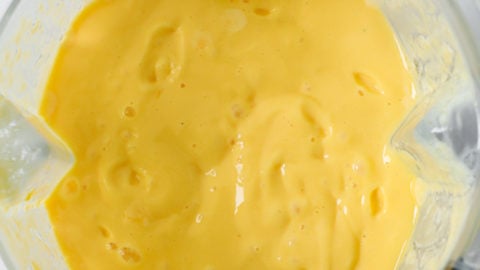



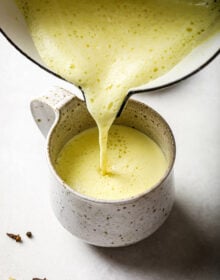

16 Comments on “The Best Mango Lassi Recipe (Restaurant-Style)”
We’ve been searching for years for a recipe that meets our lassi expectations; finally, this is it!
So glad Tea for Turmeric’s recipe was the one that met your expectations! Thank you for sharing 🙂
So yummy. But mangoes are hard to get where I live. Would it taste well with mango pulp only?
Hi Bria, many restaurants use only pulp to make it so it can certainly be done, though we do prefer adding mangoes. You can increase the pulp to maybe 1/2 cup and adjust as needed.
I cannot find mango pulp, may I use mango nectar?
That’s a great idea! Would love to hear how it works out!
Loved this recipe! I can’t do dairy so I used extra creamy oat milk and cashew yogurt and it turned out perfect!
So glad, Joleen! Thanks for sharing as I’m sure it’ll help others looking to make it vegan.
This was SO good!!
For the fresh/frozen mangoes I used two small Ataulfos which yielded the perfect amount for a 1.5x batch. Added a pinch of cardamom as suggested in the post and also a pinch of salt — absolutely divine, especially after sitting in the fridge for a bit.
I love that you included tips on how to adjust the gram measurements to tweak the results to our liking! I’m so happy to know how to make a killer mango lassi at home. Will be making this recipe on the regular now 🙂 Thank you Izzah!!
Truly delighted to hear that, Ruth! Thank you so much!
The problem is the dairy kills the mango pulp flavour, and the mango kills the yoghurt flavour leaving a faint taste of each. Buttermilk helps. Your thoughts?
That’s an interesting observation, Trent. I think you’re onto something. The yogurt flavor definitely becomes subtle as soon as mango is added to lassi. That said, I think there’s no ‘right way’ to make it. So just playing around with it and making something you like is the solution.
Even among restaurants, mango lassis vary in taste and texture. Your recipe is SUPERB and tastes & feels just like the one our favorite restaurant makes. We did everything you said to do–freezing the ripe mango chunks, weighing ingredients, buying the mango pulp. We used Brown Cow whole milk yogurt and a VitaMix blender. Unbelievably, unbelievably perfect. Thank you!
So so happy to see this comment! Sorry for the late response – I missed replying earlier due to travel! Thank you so much for sharing!
Hi, can this be made without fresh/frozen mangoes? I have some huge cans of mango pulp that needs to be used and the mangoes at the store aren’t looking very good.
Also, do you have any recommendations for making this vegan? My in laws are visiting and they’re vegan.
Thanks a bunch!
Hi Karen, many restaurants use only pulp to make it so it can certainly be done, though I do prefer adding mangoes. You can increase the pulp to maybe 1/2 cup and adjust as needed. For a vegan version, you could try using coconut yogurt & any DF milk. I’ve shared a blogger’s recipe in the post that uses lime to get the sour taste of yogurt.